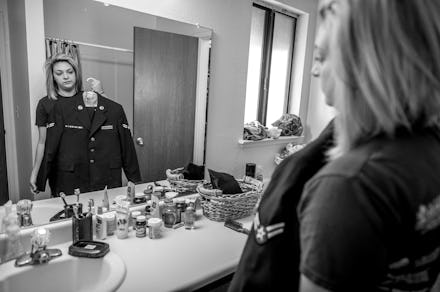Haunting Photo Essay Illustrates the Real-Life Toll of Military Sexual Assault in America

A breathtaking new photo-essay by photojournalist Mary Calvert, a Pulitzer Prize finalist, documents all facets of the recovery process for survivors of military sexual assault.
Best known for her work abroad, Calvert documented how rape is used as a tool of war, even within the U.S. military.
"I started doing research, and when I read some of the statistics, I was absolutely horrified," she told Mic. "I had spent all of this time going to other places, for instance, [the Democratic Republic of] Congo... and little did I know that this was happening in my own backyard. I felt that it was very important to tell that story."
Connie Sue Foss was raped while in the US Army and hasn't been able to hold down a job to care for herself and her daughter. She bears scars from punching a window during a PTSD episode and holds a molar she lost from grinding her teeth at night.
According to a 2013 report released by the Pentagon, 3,553 service members reported sexual assault between July 1, 2012, and June 30, 2013. Studies are only now beginning to reveal the full toll of this epidemic, but research from psychologist Craig Bryan estimates that "military victims of violent assault or rape are six times more likely to attempt suicide than military non-victims."
Calvert photographed roughly 30 military sexual assault survivors from all walks of life, to capture a variety of encounters with the recovery process after rape. All are profiled in her book, The Battle Within: Sexual Violence in America's Military. These are women on active duty, at home with their families and deep in thought.
Calvert chose mostly candid pictures because she wanted to authentically depict what day-to-day life was like for each subject.
Jennifer Norris was drugged and raped by her recruiter after joining the US Air Force when she was 21 years old. In tech school, she fought off the sexual assault of her instructor and later evaded the advances of her commanders. 'It's like being in a domestic violence marriage that you can't get divorced from,' she said.
"The way I approached it was, I imagined that I was a resident doctor in a teaching hospital. They often have very long shifts, 24-hour shifts, and they do that so the student can understand the full progress of a disease or an injury," she said. "And I wanted to do the same thing with these women."
Calvert added that she wanted to show what each woman's life was like when she was away from everyone else, offering a clear sense of how surviving sexual assault affected their everyday state of being. "I looked at the symptoms of military sexual trauma, which include include paranoia, isolation, self-medication and the ultimate would-be, suicide," she said. "I tried to show a different part of that with each person I chose to photograph."
Military rape survivors Jennifer Norris and Jennifer Hinves, smoke and discuss their assaults late into the night at Jessica's home. Hinves, was an Air Force fighter jet mechanic when she was raped by a member of her squadron at Lackland Air Force Base. The case against her rapist was thrown out the day before the trial was to begin.
One of the first women Calvert photographed was a fighter jet mechanic. Jessica Hinves was tasked with the important and intense job of making sure those planes flew, Calvert said. After reporting her assault, however, Hinves was saddled by a long investigation where she often felt as though she were on trial, rather than the alleged perpetrator. Just one night before she was due at a pre-trial hearing, a new commander told her, "While [the alleged rapist] did not act as a gentleman, there is no reason to prosecute," according to Calvert. The case was thrown out.
"Jessica is an extremely resilient person, and she's learning to live with this trauma and the subsequent betrayal by the military who didn’t take care of her," Calvert said.
The amount of courage it takes to come forward to report rape is not lost on anyone. Panayiota Bertzikis, a veteran of the U.S. Coast Guard and founder of the Military Rape Crisis Center, told Mic, "My first reaction was just awe of the brave survivors who came forward, especially those on active duty. It takes courage." Bertzikis added that what makes Calvert's project powerful is being able to put a name and face to each story and to see how being raped not only affects the service members, but also their families. "It's not just numbers, it's an actual person," she said.
Melissa Bania holds her banner, before hanging it on the foot bridge across from the entrance to Naval Station San Diego. US Navy Military Sexual Trauma survivors got together at Brittany Fintel's San Diego home to make banners inscribed with their sexual assault experiences in the US Navy.
Image Credit (all): Mary F. Calvert/ZUMA Wire